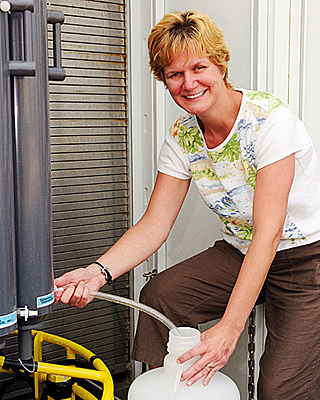
Marine mystery solved
'Rare' bacteria in the ocean ain't necessarily so, researchers report
12:48 p.m., July 20, 2011--A teaspoon of seawater contains thousands of naturally occurring bacteria. Scientists previously believed that less than half of these ocean microbes are actively taking up organic compounds, while the remainder -- a mix of rare species -- lie dormant.
Not so, according to researchers from the University of Delaware and the University of Southern California. In a study reported in the July 18 online edition of the Proceedings of the National Academy of Sciences, the UD-USC team found that over half the bacterial species sampled from ocean surface waters actively cycled between abundant and rare, and only about 12 percent always remained rare and potentially inactive.
Research Stories
Chronic wounds
Prof. Heck's legacy
“Scientists have been interested in shedding light on this so-called ‘rare biosphere’ made up of a huge diversity of bacteria,” says Barbara Campbell, assistant professor of marine biosciences in UD’s College of Earth, Ocean, and Environment. “The surprise is that many of these bacteria are actually quite active, and they cycle from low to great abundance.”
Campbell’s co-authors on the study include David Kirchman, Maxwell P. and Mildred H. Harrington Professor of Marine Biosciences at UD, and John Heidelberg, associate professor of biological sciences at USC.
Every month for three years, Campbell and colleagues collected water samples from a site in the Atlantic Ocean near UD’s Hugh R. Sharp Campus in Lewes, Del. Then using a high-throughput sequencing technique at USC, the researchers examined a portion of the genome of individual microbial species -- the ribosomal RNA -- a gene involved in enzyme production. The more copies of RNA present, the more metabolically active the cell. The team analyzed over 500,000 sequences.
For the first time, Campbell says, the team saw some of the bacteria switch from being rare to abundant. Their findings also suggest that although abundance follows activity in the majority of species, a significant portion of the rare community is active, some with growth rates that decrease as abundance increases.
“Many of these bacteria cycle between abundant and rare, and there’s a reason for that,” Campbell notes. “Bacteria that lie dormant appear to serve as seeds for the future community -- like a microbial seed bank.”
The scientists are now trying to explain what causes the cells to become dormant and active again. It doesn’t appear to be seasonally driven or to correlate much with the environment, but it may be driven by the microbial community itself, Campbell explains.
“When one bacteria is happy, it’s in association with its cousins in a community. You might say it likes it neighborhood,” Campbell says.
Better understanding the microbial world matters, Campbell points out, since these tiny organisms not only provide food for other organisms, but also affect the cycling of carbon, nitrogen and sulfur throughout the ocean and across the entire planet, with important implications for climate change and other phenomena.
She also notes that the molecular methods used in the research may be applied to other problems, such as determining at your local beach if the bacteria that affect water quality are alive and replicating.
The research was funded by a grant to Campbell from the U.S. National Science Foundation and through Kirchman’s grant from the Partner University Fund, which supports innovative partnerships between French and U.S. institutions of research and higher education.
Article by Tracey Bryant








